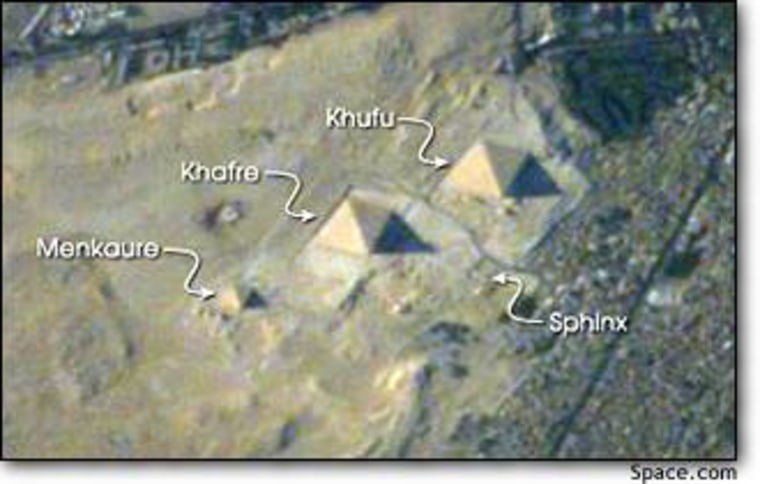There is a longstanding myth that the Great Wall of China is the only manmade object visible from space. It and several variations on the theme are great fodder for water cooler arguments. In reality, many human constructs can be seen from Earth orbit.
Shuttle astronauts can see highways, airports, dams and even large vehicles from an Earth orbit that is about 135 miles (217 kilometers) high. Cities are clearly distinct from surrounding countryside, and that’s true even from the higher perch of the International Space Station, which circles the planet at about 250 miles (400 kilometers) up.
“You can see an awful lot from space,” says astronaut Ed Lu, the science officer of Expedition Seven aboard the station. “You can see the pyramids from space, especially with a pair of binoculars. They are a little difficult to pick out with just your eyes.”
Egyptian pyramids have been photographed from space several times with standard digital cameras and high-powered lenses. The largest pyramid at Giza, on the outskirts of Cairo, is 745 feet (227 meters) wide and 449 feet (137 meters) tall.
“With binoculars you can see an awful lot of things,” Lu wrote via e-mail in fielding a question from an Earthbound space fan. “You can see roads. You can see harbors. You can even see ships; very large tankers on the ocean we can see using the binoculars.”
There are some surprises, too.
“You can see airplane contrails, and occasionally at the end of an airplane contrail, you will see a glint of sunlight off the airplane,” Lu says. “And very occasionally, you do see other satellites go by. It is kind of a neat thing to see.”
There are of course places in space from which you can’t notice how humans have sculpted the planet. Apollo astronauts could not make out manmade features from the Moon, for example. And from Mars, Earth would appear to the naked eye as nothing but a bright “star” in the night sky.
So what about the Great Wall of China?
“You can see the Great Wall,” Lu says. But it’s less visible than a lot of other objects. And you have to know where to look.
In fact stretches of the wall aren’t even visible from China. They’ve been buried by sand for centuries. NASA has used space-based radar to map out hidden parts of the ancient structure. Lu is trying to get a picture of it, too, with a digital camera.
“The weather hasn’t cooperated,” he says. “There has been a lot of clouds and haze over that area since I’ve been trying. But I hope to be successful before I come back down.”
